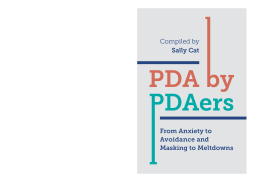
Additional Information
Book Details
Abstract
"To think of PDA as merely involving demand avoidance is to me akin to thinking of tigers as merely having stripes."
This book is a unique window into adult Pathological Demand Avoidance (PDA), exploring the diversity of distinct PDA traits through the voices of over 70 people living with and affected by the condition.
Sally Cat, an adult with PDA, has successfully captured the essence of a popular online support group in book form, making the valuable insights available to a wider audience, and creating a much-needed resource for individuals and professionals. Candid discussions cover issues ranging from overload and meltdowns, to work, relationships and parenting. This is a fascinating and sometimes very moving read.
With good humour and banter, this book demonstrates "the positive power of self-awareness" and understanding. Everyone should read it to appreciate what life is like for PDAers. Skilful Sally Cat enables PDAers to realise that other people feel the same. Shared experiences and coping strategies open the door to the realisation that they are not alone and feeling "different is ok".
Anne Waterhouse, lifelong educationalist, self-identified as relating to PDA in her 70s after reading Sally Cat’s memes
I think this is a great resource for understanding adult PDA. The NAS's website is all good, but it's only relevant to children. This book lifts the curtain. There are nuances to this condition! It itself is a spectrum I think. The parts of this book I've read have helped me to better understand some of my past behaviours. It was like looking in a mirror!
Josh Bremner, 23-year-old sound engineering student exploring PDA through the Facebook Adult DA Support Network
Unlike usual factual guides, this book brings a 'human touch' with moving tales, experiences and support from Sally Cat and her fellow PDAers. Alongside this are easy to follow and simple to understand graphs, memes and insights into the world of PDA. A wonderfully relatable book, full of humour and hope.
Victoria Power, mother of two special needs children, self-diagnosed with PDA
Sally Cat is an adult with PDA. She has compiled the book from discussions between 70+ people from around the world that have taken place within the Facebook Adult PDA Support Network.
Table of Contents
| Section Title | Page | Action | Price |
|---|---|---|---|
| PDA by PDAers— From Anxiety to Avoidance and Masking to Meltdowns —Compiled by Sally Cat | 2 | ||
| Introduction | 9 | ||
| Original post in the Adult PDA Support Network Facebook group introducing the project to fellow members | 12 | ||
| Prologue | 13 | ||
| 1. Demand Avoidance | 17 | ||
| 2. What sort of things are we driven to avoid? | 35 | ||
| 3. Anxiety and PDA | 50 | ||
| 4. PDA and Masking | 69 | ||
| 5. Intolerance of Uncertainty | 88 | ||
| 6. Control | 103 | ||
| 7. Meltdowns | 119 | ||
| 8. Overload | 147 | ||
| 9. PDA and People | 161 | ||
| 10. Hierarchy and Rules | 182 | ||
| 11. Fantasy and Role Play | 195 | ||
| 12. Wordplay | 219 | ||
| 13. Impulsiveness | 231 | ||
| 14. Routine | 238 | ||
| 15. School | 248 | ||
| 16. Work | 276 | ||
| 17. Coping Strategies | 291 | ||
| 18. Reasonable Accommodations | 305 | ||
| 19. Parenting | 314 | ||
| 20. Our Achievements | 332 | ||
| Appendix: Statistical Analyses | 350 | ||
| Glossary | 359 | ||
| List of Graphs | 6 | ||
| Graph 1: My Demand Avoidance impacts my life | 32 | ||
| Graph 2: Demand Avoidance stops me doing things I enjoy | 47 | ||
| Scattergraph 1: Correlation between Graphs 1 and 2 | 47 | ||
| Graph 3: I feel anxious in life | 66 | ||
| Scattergraph 2: Correlation between Graphs 1 and 3 | 66 | ||
| Scattergraph 3: Correlation between Graphs 2 and 3 | 67 | ||
| Graph 4: I mask | 85 | ||
| Graph 5: I need to know what’s happening (I can’t tolerate uncertainty) | 99 | ||
| Graph 6: I need control of my own life | 116 | ||
| Graph 7: My meltdowns are always obvious | 144 | ||
| Graph 8: I overload easily | 158 | ||
| Scattergraph 4: Correlation between Graphs 1 and 8 | 158 | ||
| Graph 9: I have had obsessions about people | 179 | ||
| Graph 10: I respect competency rather than rank | 192 | ||
| Graph 11: I have (now or in the past) daydreamed a lot | 215 | ||
| Graph 12: I enjoy wordplay | 226 | ||
| Graph 13: I am impulsive | 235 | ||
| Graph 14: I find routine comforting, as long as it isn’t imposed on me | 245 | ||
| Scattergraph 5: Correlation between Graphs 3 and 14 | 245 | ||
| Graph 15: I enjoyed school | 272 | ||
| Graph 16: I am able to work to earn a wage | 287 | ||
| Scattergraph 6: Correlation between Graphs 1 and 16 | 287 | ||
| Scattergraph 7: Correlation between Graphs 3 and 16 | 288 | ||
| Graph 17: I avoid talking on the phone | 300 | ||
| Graph 18: I need access to a quiet place | 311 | ||
| Graph 19: I felt my parents understood me as a child | 326 | ||
| Graph 20: I can achieve a lot, but need space and \nautonomy to do it my own way | 349 |
